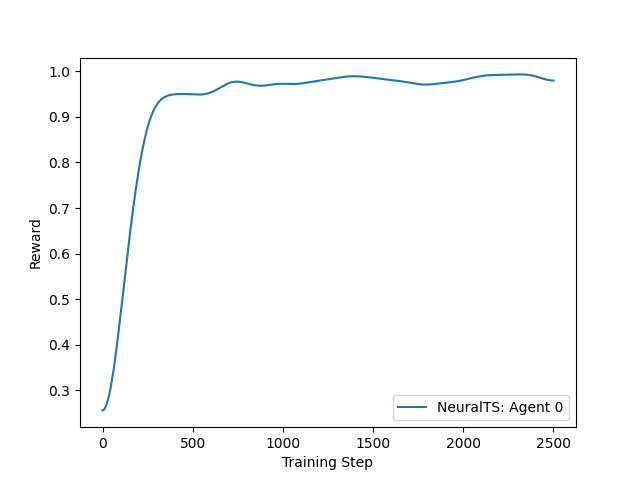Iris with NeuralUCB¶
In this tutorial, we will be training a NeuralUCB agent to solve the Iris dataset, converted into a bandit environment.
To complete the Iris environment, the agent must learn to select the best arm, or action, to take in a given context, or state.

Figure 1: Cumulative regret from training on the Iris dataset¶ |

Figure 2: Reward from training on the Iris dataset¶ |
NeuralUCB (Neural Contextual Bandits with UCB-based Exploration) utilizes the representational capabilities of deep neural networks and employs a neural network-based random feature mapping to create an upper confidence bound (UCB) for reward, enabling efficient exploration.
For this tutorial, we will use the labelled Iris dataset from the UCI Machine Learning Repository.
These datasets can easily be imported and used for training with the Python package ucimlrepo, and to choose from the hundreds of
available datasets it is as simple as changing the id parameter used by fetch_uci_repo.
We can convert these labelled datasets into a bandit learning environment easily by using the agilerl.wrappers.learning.BanditEnv class.
"""This tutorial shows how to train an NeuralUCB agent on the IRIS dataset.
Authors: Nick (https://github.com/nicku-a)
"""
import matplotlib.pyplot as plt
import numpy as np
import torch
from scipy.ndimage import gaussian_filter1d
from tqdm import trange
from ucimlrepo import fetch_ucirepo
from agilerl.components.replay_buffer import ReplayBuffer
from agilerl.utils.utils import initialPopulation
from agilerl.wrappers.learning import BanditEnv
if __name__ == "__main__":
device = torch.device("cuda" if torch.cuda.is_available() else "cpu")
NET_CONFIG = {
"arch": "mlp", # Network architecture
"hidden_size": [128], # Actor hidden size
}
INIT_HP = {
"POPULATION_SIZE": 1, # Population size
"BATCH_SIZE": 64, # Batch size
"LR": 1e-3, # Learning rate
"GAMMA": 1.0, # Scaling factor
"LAMBDA": 1.0, # Regularization factor
"REG": 0.000625, # Loss regularization factor
"LEARN_STEP": 1, # Learning frequency
# Swap image channels dimension from last to first [H, W, C] -> [C, H, W]
"CHANNELS_LAST": False,
}
# Fetch data https://archive.ics.uci.edu/
iris = fetch_ucirepo(id=53)
features = iris.data.features
targets = iris.data.targets
env = BanditEnv(features, targets) # Create environment
context_dim = env.context_dim
action_dim = env.arms
pop = initialPopulation(
algo="NeuralUCB", # Algorithm
state_dim=context_dim, # State dimension
action_dim=action_dim, # Action dimension
one_hot=None, # One-hot encoding
net_config=NET_CONFIG, # Network configuration
INIT_HP=INIT_HP, # Initial hyperparameters
population_size=INIT_HP["POPULATION_SIZE"], # Population size
device=device,
)
field_names = ["context", "reward"]
memory = ReplayBuffer(
action_dim=action_dim, # Number of agent actions
memory_size=10000, # Max replay buffer size
field_names=field_names, # Field names to store in memory
device=device,
)
max_episodes = 50 # Max training episodes
max_steps = 50 # Max steps per episode
evo_epochs = 2 # Evolution frequency
evo_loop = 1 # Number of evaluation episodes
print("Training...")
regret = [[0] for _ in pop]
score = [[0] for _ in pop]
total_steps = 0
# TRAINING LOOP
for idx_epi in trange(max_episodes):
for i, agent in enumerate(pop): # Loop through population
losses = []
context = env.reset() # Reset environment at start of episode
for idx_step in range(max_steps):
# Get next action from agent
action = agent.getAction(context)
next_context, reward = env.step(action) # Act in environment
# Save experience to replay buffer
memory.save2memory(context[action], reward)
# Learn according to learning frequency
if (
memory.counter % agent.learn_step == 0
and len(memory) >= agent.batch_size
):
for _ in range(2):
experiences = memory.sample(
agent.batch_size
) # Sample replay buffer
# Learn according to agent's RL algorithm
loss = agent.learn(experiences)
losses.append(loss)
context = next_context
score[i].append(reward)
regret[i].append(regret[i][-1] + 1 - reward)
total_steps += max_steps
# Now evaluate population
if (idx_epi + 1) % evo_epochs == 0:
# Evaluate population
fitnesses = [
agent.test(
env,
swap_channels=INIT_HP["CHANNELS_LAST"],
max_steps=max_steps,
loop=evo_loop,
)
for agent in pop
]
print(f"Episode {idx_epi+1}/{max_episodes}")
print(f"Regret: {[regret[i][-1] for i in range(len(pop))]}")
# Plot the results
plt.figure()
for i, agent_regret in enumerate(regret):
plt.plot(
np.linspace(0, total_steps, len(agent_regret)),
agent_regret,
label=f"NeuralTS: Agent {i}",
)
plt.xlabel("Training Step")
plt.ylabel("Regret")
plt.legend()
plt.savefig("NeuralUCB-IRIS-regret.png")
plt.figure()
for i, agent_score in enumerate(score):
smoothed_score = gaussian_filter1d(agent_score, sigma=80)
plt.plot(
np.linspace(0, total_steps, len(smoothed_score)),
smoothed_score,
label=f"NeuralTS: Agent {i}",
)
plt.xlabel("Training Step")
plt.ylabel("Reward")
plt.legend()
plt.savefig("NeuralUCB-IRIS-reward.png")